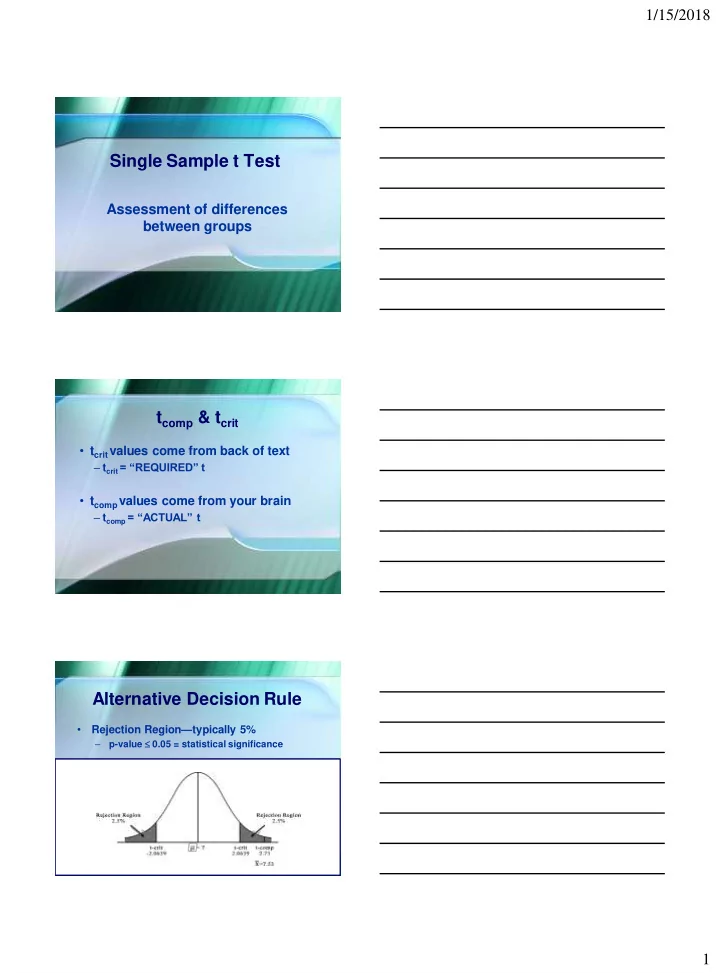

1/15/2018 Single Sample t Test Assessment of differences between groups t comp & t crit • t crit values come from back of text – t crit = “REQUIRED” t • t comp values come from your brain – t comp = “ACTUAL” t Alternative Decision Rule • Rejection Region — typically 5% – p-value 0.05 = statistical significance 1
1/15/2018 Alternative Decision Rule • Reject Null if |t comp | > t crit – If critical t = 2.0639, then sample & pop means are required to be at least 2.0639 standard error units apart in order to reject What does rejection really mean? “There is a less than 5 in 100 chance 1. that the sample came from the population.” “There is less than a 5% probability 2. that the difference between the sample and population averages is due to coincidence.” “There is a 95% or better probability 3. that the difference between the sample and population is due to something real.” Treating mean differences like Z scores • Z score deviance • Problem: Group distributions contain error and are not normally distributed. • Solution: t distribution – deviance of mean difference X t X s X 2
1/15/2018 What is my digit span? One-Sample t Walkthrough • A researcher is interested in the effect of amphetamine on short-term memory. To test this, she has 25 adult volunteers swallow a small dose of amphetamine, wait 30 minutes, and take a digit-span test. The researcher finds that the mean digit-span for the subjects is 7.53, with a standard deviation of .97. She knows from many previous studies that the average adult digit span is 7. If we assume that µ=7, what is the probability of selecting a sample of size N = 25, M = 7.53, if only chance is involved? In other words, how likely is it that the amphetamine had a real (non-chance) effect on digit span? Type I and Type II Errors Cross your fingers… mistakes are always possible 3
1/15/2018 Correct & Incorrect Decisions In reality, H 0 is… True False We decide to… Correct Type II Accept False Negative Correct Type I Reject False Positive Type I Error • Type I error : Null rejected when it is true – Like saying “ I found something” …when really nothing there (over- reacting) – Also called alpha ( α ) error or a “false positive” Type II Error • Type II error : Null not rejected (accepted) when it is false – Like saying “ II bad. Nothing there,” …when really was something (under-reacting) – Also called beta error ( ) or a “miss” 4
1/15/2018 Choosing an Alpha Level Consequences of our decisions 5
1/15/2018 Minimize chance of Type I error... … with smaller • – Common values are = 0.01 and 0.05 • “How small” depends on seriousness of Type I error • Decision is practical not statistical • When might we be more or less cautious about making Type I errors? In different types of criminal trials? Certain medications? The mechanic inspects the brake pads for the minimum allowable thickness. Ho: Vehicles breaks meet the standard for the minimum allowable thickness. H1: Vehicles brakes do not meet the standard for the minimum allowable thickness. Situation: The breaks are fine, but the check indicates you need to replace the brake pads; therefore any possible problems with breaks are avoided even though the breaks were not worn. Type 1 or Type 2? Situation: The pads are too thin but the mechanic does not find anything wrong with them and does not replace them. Consequently the driver of the vehicle gets into an accident because she was unable to break effectively and gets into a fatal accident. Type 1 or Type 2? POWER! A critical factor for researcher and reviewer 6
1/15/2018 What is Power? • Power : probability concluding difference when really IS a difference • Power related to alpha, beta (Types I and II error), sample size, treatment effect 1 1 – GOOD OD! 0 – BAD! Power related to alpha, beta (Types I and II error), sample size, treatment effect How w make ke big g power er? www.rpsychologist.com 7
Recommend
More recommend